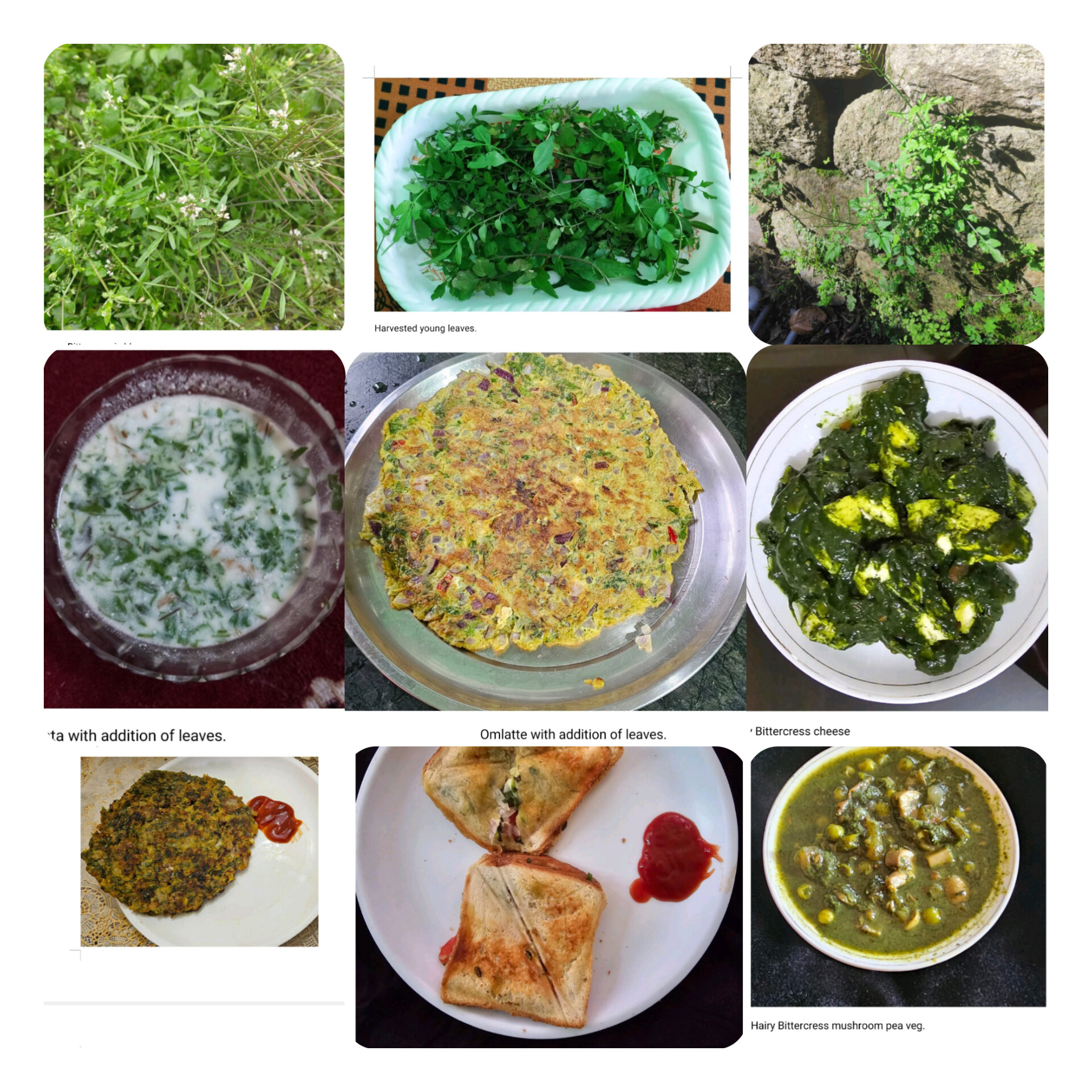From Weed to Wonder: The Delicious Tale of Cardamine Hirsuta: Dr. Tara Devi Sen.
Cardamine hirsuta: A Hidden Winter Delicacy with Remarkable Potential.

Shimla:
In the winter of 2019, while eagerly working on documenting the wild vegetables of Himachal Pradesh, I had the privilege of discovering a truly exceptional winter annual—Cardamine hirsuta, locally known as Gujjar Ghas. This unassuming plant, often overlooked as a weed, captured my attention as I engaged in conversations with villagers and elders who shared their knowledge of the region’s flora. My curiosity deepened when I noticed local women selling bundles of Gujjar Ghas alongside mustard greens (Brassica spp.) in village markets.


Intrigued by their recommendations, I began exploring the plant further. Literature highlighted that Cardamine hirsuta is one of the most delicious winter annuals, and its reputation only fueled my desire to taste it. Growing abundantly in shady, moist habitats, I found it thriving as a weed in fields, gardens, rocky walls, and hedges. Its widespread presence made it a cost-free, chemical-free, and easily accessible source of nutrition and flavor.
When I finally cooked and tasted Gujjar Ghas, its peppery and zesty flavor exceeded my expectations. It was genuinely delicious, and from that moment on, it became an integral part of my repertoire of wild vegetables.


It is commonly known as Hairy Bittercress and comes from family Brassicaceae
Why Cardamine hirsuta Deserves a Place in Your Kitchen
Cardamine hirsuta is not just another wild plant; it’s a culinary delight waiting to be embraced. Its integration into my diet has been a transformative journey. Whether paired with traditional winter greens like mustard or used as a standalone ingredient, it never fails to impress.
Its adaptability and nutritional value make it a perfect fit for modern lifestyles, offering a sustainable alternative to store-bought greens. By incorporating it into your meals, you not only savor its unique taste but also contribute to the preservation of traditional knowledge and the promotion of sustainable food practices.


Nutritional Treasure:
The plant is rich in vitamins C and A, calcium, potassium, and iron, offering a nutrient boost during the winter months.
Culinary Versatility:
What makes Hairy Cardamine hirsuta is not just another wild plant; it’s a culinary delight waiting to be embraced. Its integration into my diet has been a transformative journey. Whether paired with traditional winter greens like mustard or used as a standalone ingredient, it never fails to impress.
Its adaptability and nutritional value make it a perfect fit for modern lifestyles, offering a sustainable alternative to store-bought greens. By incorporating it into your meals, you not only savor its unique taste but also contribute to the preservation of traditional knowledge and the promotion of sustainable food practices.
So, the next time you spot this peppery winter weed in your garden or the local market, don’t dismiss it as just another wild plant. Give it a try, and you might find yourself adding Gujjar Ghas to your list of winter essentials—just as I did.


Traditionally, this humble wild herb is cooked as a simple leafy vegetable or saag, but modern times call for a creative twist to lure children and younger generations into appreciating these wholesome greens. With a little innovation, we can seamlessly weave Gujjar Ghas into a variety of dishes, blending tradition with contemporary culinary flair.


Here are some delicious ways to incorporate this wild green into your meals:
1. Winter Salads
The tender, young leaves of Hairy Bittercress are a perfect addition to fresh salads. Their peppery zing adds vibrancy and complements other greens, creating a refreshing and flavorful dish.
2. Peppery Pesto
Turn Hairy Bittercress into a one-of-a-kind winter pesto. Blend the leaves with garlic, nuts, olive oil, and a touch of cheese to create a zesty spread. This versatile pesto pairs wonderfully with pasta or as a topping for roasted vegetables.
3. Soups with a Twist
Sprinkle a handful of these zesty leaves over soups for added texture and a burst of flavor. Their subtle pepperiness enhances both creamy and broth-based soups.
4. Sandwiches and Wraps
Elevate your sandwiches, wraps, or even Indian-style chillas with a sprinkle of Hairy Bittercress leaves. Their fresh, spicy crunch adds depth and a delightful twist to everyday meals.
5. Infused Chillas, Paranthas, and Omelettes
Incorporate Hairy Bittercress into your batter for chillas or knead it into dough for stuffed paranthas. It’s also a fantastic addition to omelettes, infusing a distinctive flavor that perfectly complements these traditional staples.
The peppery taste of Cardamine hirsuta is subtle yet versatile, making it an excellent companion to an array of dishes—from simple, rustic salads to more elaborate gourmet creations. By giving a modern edge to traditional recipes, we not only preserve the culinary heritage of these wild greens but also make them appealing to new generations. So, get creative and let this vibrant winter green breathe new life into your kitchen!
Medicinal and Traditional Uses
Cardamine hirsuta has a long history of medicinal use in folk medicine. Traditionally, it has been utilized for its diuretic and anti-inflammatory properties. It is believed to help in detoxifying the liver and improving digestion, making it a valuable winter remedy to counteract sluggishness and low energy levels. In addition to its digestive benefits, the plant has also been used to treat mild skin irritations due to its anti-inflammatory effects.
Foraging Tips: A Winter Green You Can Harvest
Finding Hairy Bittercress is easy, especially in the winter months when it flourishes in the cold weather. Here’s how you can identify and harvest it:
Appearance: Hairy Bittercress forms a low-growing rosette with small, deeply lobed leaves. Its tiny white flowers are a clear indicator of the plant, blooming from winter into early spring.
Location: You’ll find it growing in moist, disturbed areas like garden beds, along sidewalks, and in cracks in the pavement. It’s a resilient plant that thrives in both urban and rural environments.
Harvesting: The young, tender leaves are the most flavorful. Harvest them by pinching off the tops, and be sure to leave the roots intact to allow the plant to continue growing.
As with any foraging, ensure that the area is free from pollutants or pesticides to guarantee safe consumption.
So, next time you’re out foraging or walking through your garden, keep an eye out for this hidden winter gem. By incorporating Hairy Bittercress into your meals, you not only enjoy a delightful flavor but also embrace the sustainable, nutrient-rich bounty that nature provides during the colder months.
Writer of this article is Dr. Tara Devi Sen, Head of Botany Department Government Vallabh College Mandi.




